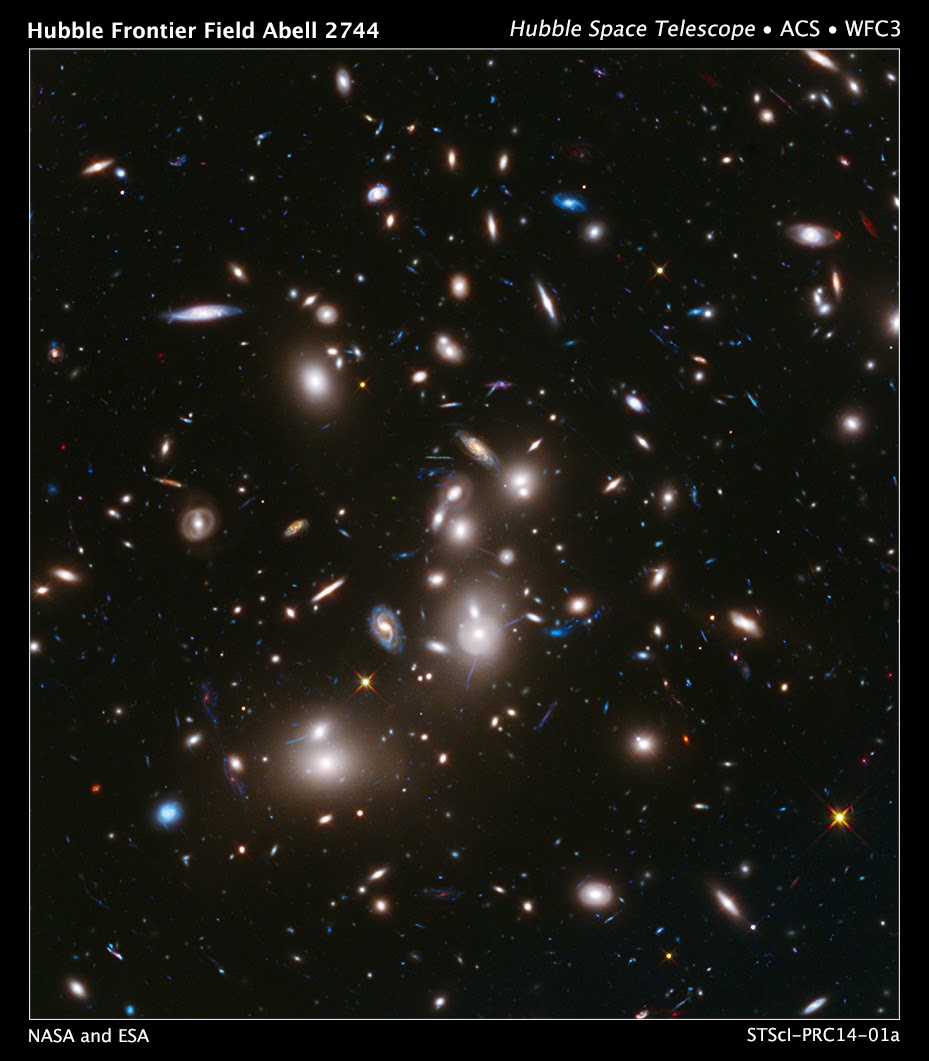Hello all,
My junior year has already rolled into action, and I thought it would be a good idea to "round up" on what I've accomplished last year as a sophomore, generally summarizing details to put them into a much more organized manner.
I am working with Dr. John Moustakas, a professor a Siena College, NY on the topic of discovering new galaxies. Dr. Moustakas has been collaborating with a team known as CLASH (Cluster Lensing And Supernovae survey with Hubble) and has conducted extensive research on many galaxy clusters. His team just concluded research on Galaxy Cluster Abell 2744 and moved onto researching Galaxy Cluster MACSJ0416-2403.
 |
| Galaxy Cluster MACSJ0416-2403 |
Regarding progress of work from my sophomore year, I was able to analyze galaxy cluster Abell 2744, backed up by Dr. Moustaka's work. A lot of time was spent on understanding the background information regarding the Galaxy Cluster Abell 2744.
The Universe is believed to have been created about 13.7 billion years ago in an event called the Big-Bang. This is supported through the analysis of cosmic microwave background, thermal radiation left over from he Big Bang. Primordial atoms were created (hydrogen, helium) and they eventually clumped together forming stars. After that stars began to clump together to form the earliest galaxies. Eventually these early galaxies collided and merged with others to form the modern galaxies we know today (ie: Milky Way, M101, M64).
In order to understand our galaxies we know today, having a good understanding on the earliest galaxies is a must. These early galaxies are known as Lyman Break Galaxies (LBGs). Before we discuss (LBGs) we must understand the effect of redshift.
Redshift is the "stretching" of wavelengths, making them shift towards the red side of the electromagnetic spectrum. Redshift is caused by the constant expansion of the Universe. For example, an X-Ray stretching it's wavelength to visible light.
 |
| Notice how the spectrum shifts towards the red part of the spectrum the father the celestial object is from the viewer's location. |
Much of the light we see in space is in the visible part of the spectrum. However since space stretches 13.7 billion light years across (and counting) redshift causes visible light produced from the early galaxies to stretch from the visible part of the spectrum to the infrared part of the spectrum. This affects the early LBGs in great amounts. Because of the Universe's expansion, the redshift in the universe causes distant galaxies (12 billion years or older) to become invisible to visual-light observing instruments.
Another factor that affects LBGs (particularly in massive galaxy clusters) is gravitational lensing. Gravitational lensing is when the gravity that is between galaxies that make up the cluster becomes so strong, it causes light to bend. The light warps, magnifies, and duplicates the background light. Gravitational lensing allows Astronomers to look at light that would be almost impossible to see without the gravitational lens. This allows us to "cheat" and look at much earlier galaxies.
 |
| The streaks/smears of light is actually light produced from galaxies behind the Galaxy Cluster. |
Now, Lyman Break Galaxies are galaxies that are star-forming galaxies at high redshift. These galaxies are identified through a technique known as the Lyman-break technique. The Lyman Break technique is a technique used to observe a galaxies Lyman limit. The Lyman limit corresponds to the most energetic photons that can be emitted from hydrogen. The known Lyman limit is around 91 nm, this represents the energy required to remove an electron completely from a hydrogen atom, starting at the lowest energy level. The Lyman break technique is really helpful when it comes to determining the redshift of the galaxy, because it compares the observed wavelength to the emitted wavelength.
Here is the official formula for the wavelength based redshift equation:

For example,
A galaxy with a redshift of 7.2 would have it's wavelength observed at around 10,000 angstroms, due to the expansion of the universe. This causes wavelengths of light to be stretched towards the red end of the electromagnetic spectrum, hence the term "redshift" . However, technically it's real emitted wavelength would be around 1215 angstroms. This data is plugged into the equation to prove that the galaxy's wavelength is around 7.2.
Lyman break galaxies with a high redshift tend to not appear in the visual filter. This is due to the lightwavelengths emitted from galaxies to be shifted into the infrared sectiopn of the electromagnetic spectrum. This is caused by the expansion of the universe. The Lyman break helps represent when the galaxy becomes observable, as the galaxy is observed under mulptiple filters based on designated wavelengths. For example, the Hubble Space telescope observes these Galaxy clusters under many different filters which range from wavelengths of 814 microns (visual) to 1600 (infrared).
More to Come!







.PNG)
.PNG)




.jpg)








